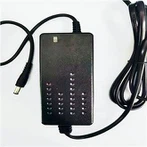There are many types of chargers, such as lead-acid battery chargers, nickel-cadmium battery chargers, nickel-hydrogen battery chargers, lithium-ion battery chargers, etc. Today I will share with you the lithium-ion battery charger.
Lithium battery charger
Lithium-ion batteries (lithium batteries for short) have high weight-to-energy density and volume-to-energy density, no memory effect, rechargeable, longer service life, environmentally friendly, and cheaper prices.
These characteristics of lithium batteries have promoted the development of portable products to be smaller and lighter. At the same time, there are more and more opportunities for products in other applications to use lithium-ion batteries as power sources.
The disadvantage of lithium batteries is that they have harsh charging requirements and need to be equipped with special chargers.
Lithium battery charging mode: first constant current charging, and then constant voltage charging until the cut-off current ends.
In order to effectively use the battery capacity, it is usually necessary to charge the lithium battery to the highest voltage, but over-voltage charging will cause damage to the battery and cause safety problems. Therefore, the charger is required to be equipped with high-precision circuit control.
For the battery with too low a voltage, it is necessary to precharge with a small current to improve the battery charging efficiency and prolong the service life. High-quality lithium battery chargers usually have a pre-charge function.
The lithium battery charger has a distinction between fast charging and slow charging
When the charging current is between 0.2C and 0.5C, it is called slow charging. Charging current greater than 0.5C, less than 1C is fast charging. When the charging current is greater than 1C, it is called high-rate charging.
C is the abbreviation of the first letter of the English "Capacity", which is used to indicate the current multiplier value during battery charging and discharging.
For example: when the rated capacity of the battery is 2000mAh, 1C=2000mA, 0.5C=0.5 x 2000mA=1000mA. For example, if a battery with a rated capacity of 2500mAh is discharged at a rate of 0.5C (1250mA), it means that the battery can last for 2 hours.
When the battery is charged at a high rate, the battery heats up very seriously, which affects the charging capacity and service life. Therefore, the standard charging current of the lithium battery industry is 0.2C.
The charging temperature of the lithium battery is preferably 0~45℃, too high a charging temperature will reduce the battery charging efficiency and bring safety problems. For this reason, there is an overheating protection circuit inside the charger to provide additional protection for the battery.
Tips:
When using a charger purchased on the market to charge the battery, due to the quality of each manufacturer's product, you need to pay attention to the following:
1. The charger is smoking: unplug the charger quickly and take out the battery. The smoke from the charger is generally caused by the burning out of the transformer due to the excessively high mains voltage.
2. The battery is hot: stop charging immediately, disconnect the charger from the battery, and move the battery outdoors to prevent possible danger. Batteries are generally hot due to high ambient temperature or abnormalities inside the battery.
3. Battery leakage: remove the battery quickly, stop charging, and then wipe the charger clean. A leaking battery indicates that the battery is damaged and can no longer be used.
4. Unable to charge: the first check whether the charger and battery are matched. If the charger is correct and still unable to charge, then the product should be sent to the manufacturer's after-sales service for processing, and the charger and battery should not be disassembled privately






